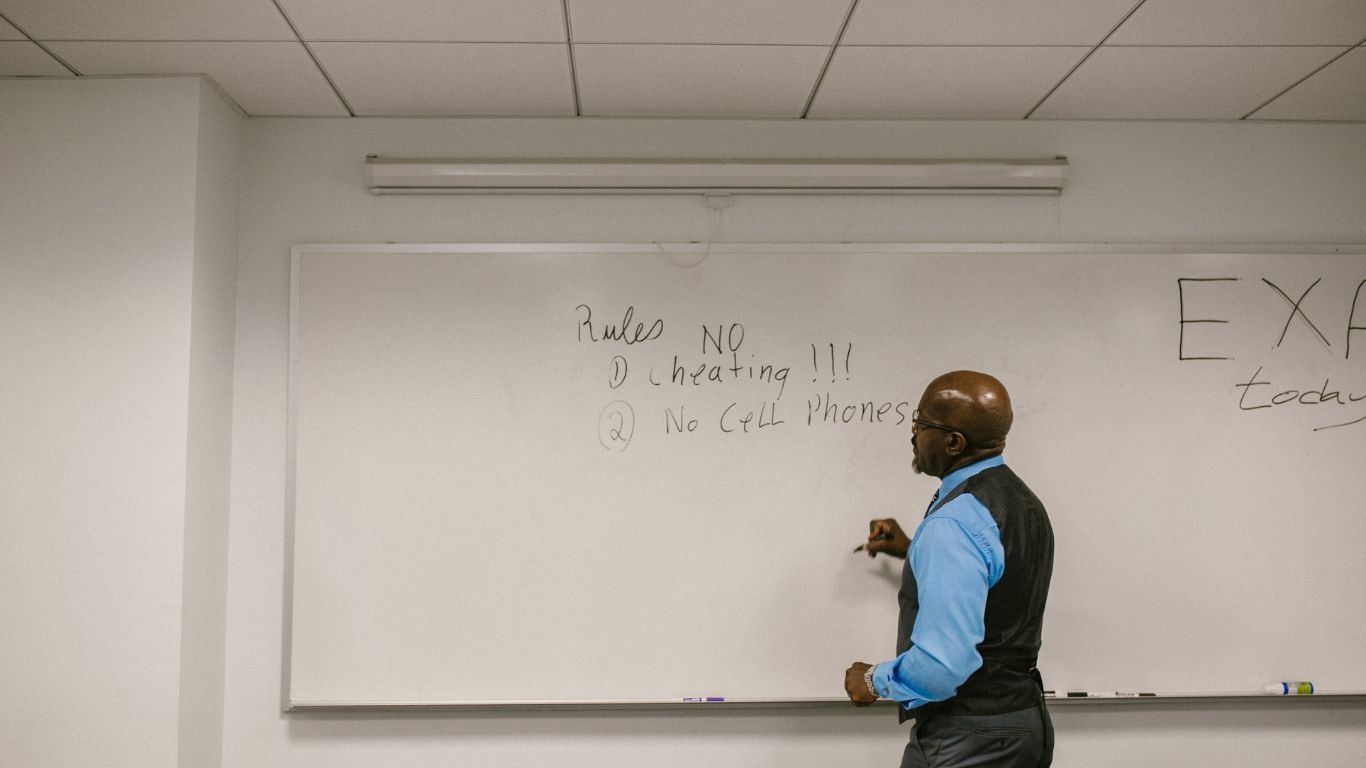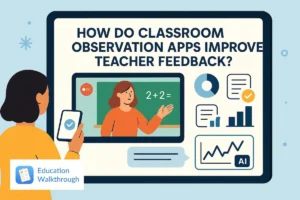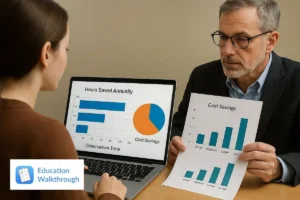Navigating T-TESS evaluation cycles can feel like walking a tightrope for many educators. The process often presents challenges.
However, understanding the question, “What are the common challenges in T-TESS evaluation cycles?” can shed light on ways to refine the process. Hence, this approach will make it more productive and beneficial for everyone involved.
Key Takeaways:
- Inconsistent rubric interpretation: This can skew the teacher evaluation process, highlighting the need for regular calibration sessions among appraisers to ensure fairness and accuracy.
- Perceived as punitive: Many educators feel that T-TESS evaluations are more about judging them than helping them grow. Creating a culture that emphasizes constructive feedback and collaboration can change that.
- Clear communication is key: Transparency about the goals and processes behind T-TESS can foster trust and make evaluations feel like a partnership rather than a performance review.
Inconsistency in Rubric Interpretation
One of the most common hurdles in T-TESS evaluation cycles is the way different educators and appraisers interpret the rubric. Those performance descriptors, intended to distinguish between “Proficient” and “Accomplished,” can sometimes feel ambiguous. It only leaves both teachers and evaluators unsure of how to apply them consistently.
For example, one appraiser might consider a teacher “Proficient” in student engagement. On the other hand, another might rate the same evidence as “Accomplished,” simply due to personal interpretation.
Furthermore, limited calibration opportunities only exacerbate the problem. When appraisers don’t regularly align their understanding of the rubric, the result is inconsistent evaluations that can feel unfair or arbitrary. This inconsistency not only impacts teacher morale but can also undermine the credibility of the evaluation process itself.
At Education Walkthrough, we understand how frustrating this can be. That’s why we always emphasize the importance of regular calibration sessions. By dedicating time for appraisers to discuss and align their interpretations, schools can ensure a fairer, more transparent evaluation process.
Perceived Punitive Nature of Evaluations

Another challenge that consistently arises in Texas teacher evaluation cycles is the perception that evaluations are punitive rather than supportive. Many educators enter the evaluation process expecting judgment, fearing that one misstep could negatively impact their career trajectory. This mindset can overshadow the intended purpose of T-TESS as a tool for professional development for teachers, turning what should be a reflective and growth-oriented process into a source of stress and anxiety.
Changing this perception requires intentional effort from both administrators and educators. Framing T-TESS as a tool for ongoing support, coaching, and professional development helps teachers view evaluations as opportunities for growth rather than obstacles to navigate.
Peer observation and collaborative feedback mechanisms also play a key role in transforming this perception. When teachers observe each other and engage in constructive dialogue, the evaluation cycle becomes a shared journey toward excellence rather than a solitary, judgment-heavy exercise.
Lack of Transparent Communication
Transparent communication is the bedrock of any effective evaluation system, yet it often falls short in T-TESS evaluation cycles.
When educators lack a clear understanding of why they are being evaluated, how their performance is being measured, and what the ultimate goals of the process are, trust can quickly erode. Without this clarity, the entire evaluation process can feel like a mystery.
This communication barrier in instructional coaching can leave teachers wondering if the feedback they receive is based on an arbitrary set of criteria or the personal preferences of the appraiser. Moreover, this lack of understanding can lead to anxiety, frustration, and even resistance to the evaluation process altogether.
Clarity and transparency make all the difference. We strongly advocate for open communication at every stage of the evaluation process.
More than just providing teachers with the “what” of the evaluation process, communication should also address the “why.”
Why is feedback being delivered in a particular way?
Why are certain practices emphasized over others?
This deeper level of communication enables educators to align their professional growth with the broader goals of the school or district, thereby fostering a culture of continuous improvement.
Insufficient Observation Time

The value of a well-conducted classroom observation is immeasurable. Yet one of the most significant barriers to effective T-TESS evaluations is the lack of sufficient observation time.
In many districts, time constraints prevent appraisers from conducting the in-depth, comprehensive observations necessary to capture an educator’s practice fully. For teachers, this can feel like being evaluated on a snapshot of their performance, rather than an accurate representation of their abilities and growth over time.
When appraisers have limited time to observe a teacher, they may only witness a small portion of the class, which can lead to incomplete or superficial feedback. For example, an appraiser might miss key moments of student engagement or the teacher’s handling of a classroom challenge.
Without the whole picture, it’s difficult to give truly actionable feedback that highlights a teacher’s strengths or offers suggestions for growth. It also means teachers might not have the opportunity to show their full range of skills, from classroom management to differentiated instruction.
Furthermore, when time for reflection and feedback is squeezed into short meetings, the depth of the conversation often suffers. Educators may not have the chance to discuss what went well fully, explore areas for improvement, or brainstorm strategies for growth. Feedback becomes rushed, and teachers miss out on the opportunity to engage in reflective dialogue that could be the catalyst for change in their practice.
Many schools face challenges with time management, but this doesn’t mean the solution is out of reach. By prioritizing observation time in teachers’ schedules, schools can ensure that feedback is thorough, timely, and most importantly, effective. This can be achieved through dedicated blocks for appraisers or by scheduling regular check-ins throughout the year. Additionally, this may involve adjusting schedules or implementing more flexible structures for observations; however, the benefits far outweigh the costs.
High Volume of Required Documentation
One of the most frequently cited challenges in the T-TESS evaluation cycle steps is the sheer volume of documentation required. Teachers and administrators alike often find themselves juggling pre-conference notes, formal observation records, and post-conference reflections. All of which can quickly become overwhelming.
For administrators, this extensive documentation can pull focus away from other essential responsibilities, creating a tension between compliance and meaningful instructional support.
At Education Walkthrough, we understand how exhausting this can feel. That’s why we advocate for strategies to streamline the process without compromising the quality of evaluations. Utilizing templates, shared digital resources, and batching feedback can significantly reduce the administrative load.
Also, our platform enables administrators and evaluators to easily capture and organize classroom observations in real-time, centralizing all notes and evidence in one accessible location. When you tap into the Education Walkthrough platform, you can free up more time for meaningful feedback and professional growth conversations, making the evaluation process more efficient and impactful.
Challenges with Student Growth Measures

Integrating student achievement measures into T-TESS evaluations is another common hurdle, often raising questions among educators about the fairness and relevance of these evaluations. Many teachers feel that these measures can seem disconnected from daily instructional practices, making it difficult to use the data effectively in shaping their professional growth. When student growth measures don’t align with classroom realities, educators may view evaluations as arbitrary or less credible.
Implementing student growth measures effectively requires careful alignment with the Texas Teacher Standards and thoughtful consideration of how these metrics reflect both student performance and engagement. This task is complex, especially across multiple schools and classrooms, where student populations and instructional approaches can vary widely.
Scheduling Constraints
Another challenge that frequently emerges in T-TESS evaluation cycles is scheduling. Formal observations are often restricted during the first two weeks of school and near the end of the academic year, compressing the available window for evaluations. These limitations can make it challenging to schedule observations at times that best reflect a teacher’s practice, sometimes resulting in rushed or incomplete assessments.
Additional complications arise when teachers take medical, personal, or professional leave during these restricted periods. Observations may need to be rescheduled, adding stress for both teachers and appraisers. When the observation window is compressed, there’s less opportunity for reflective feedback, follow-up conversations, or thorough documentation, which can reduce the overall effectiveness of the evaluation process.
How to Find Time for T-TESS Pre and Post Conferences
Hence, we always emphasize proactive planning and flexibility. Schools should carefully coordinate observation schedules and accommodate individual teacher needs. This approach ensures that evaluations occur in meaningful contexts rather than simply filling calendar slots.
Budgetary and Logistical Constraints

Limited funding can restrict administrators’ opportunities to attend essential training sessions offered by Regional Education Service Centers, leaving them less prepared to conduct thorough and equitable evaluations. Similarly, logistical hurdles, such as limited access to observation tools or insufficient time for calibration sessions, can hinder the effectiveness of the T-TESS process.
Collaborative efforts can also help mitigate these challenges. Districts can partner with schools, educators, colleagues, and even the Texas Education Agency to share resources, training opportunities, and innovative solutions. This collaborative approach fosters a more sustainable system, ensuring that T-TESS evaluations remain both meaningful and impactful over time.
Overcoming Challenges with Professional Development
Effective professional development not only aligns with the T-TESS rubric dimensions but also meets the specific needs of teachers. When professional development focuses on actionable feedback, continuous improvement, and practical classroom strategies, it enables educators to refine their practice, strengthen their professional skills, and enhance student outcomes.
Technology, like classroom walkthrough software, can further enhance professional development efforts. Real-time observation tools allow appraisers to provide immediate, personalized feedback, making professional growth more relevant and timely. Teachers can receive targeted suggestions on classroom management, instructional strategies, and student engagement, turning evaluation feedback into a dynamic growth opportunity rather than a static report.
Ongoing learning isn’t just for teachers, though. Appraisers also benefit from continuous development. Calibration sessions, peer reviews, and instructional coaching opportunities equip evaluators to consistently and fairly provide evidence-based feedback.
Summary
The T-TESS evaluation cycle comes with its share of challenges, from inconsistent rubric interpretations to heavy documentation. But with clear communication, adequate observation time, and a strong focus on professional development, these hurdles can be overcome.
At Education Walkthrough, our platform helps streamline observations, simplify documentation, and provide actionable feedback in real time. By utilizing our tools, districts and educators can make T-TESS evaluations more efficient, transparent, and growth-focused.
Frequently Asked Questions
Have questions? Education Walkthrough has the answers. Here’s what you need to know:
What are the main components of the T-TESS?
The main components of the T-TESS are collaboration on goals and a professional development plan, an evaluation cycle that includes pre-conference, observation, and post-conference, as well as student growth measure options. These elements work together to enhance teacher effectiveness and student learning.
How does T-TESS address the issue of inconsistency in rubric interpretation?
T-TESS addresses inconsistency in rubric interpretation through regular calibration sessions and training for appraisers, which promotes uniformity and fairness in evaluations. This approach effectively minimizes variability among different evaluators.
Why do many educators perceive T-TESS evaluations as punitive?
Many educators perceive T-TESS evaluations as punitive because they feel these evaluations focus more on accountability than on fostering professional growth, leading to anxiety about the potential negative impacts on their careers.
What are some best practices for managing the high volume of required documentation in T-TESS?
Implementing templates, leveraging shared digital resources, and batching feedback are effective strategies for managing T-TESS documentation. These practices can significantly reduce administrative workload while promoting impactful instructional growth.
How can professional development help overcome challenges in T-TESS evaluations?
Professional development is essential for addressing challenges in T-TESS evaluations as it aligns with the rubric dimensions and emphasizes continuous improvement. Utilizing tools like classroom walkthrough software can provide immediate feedback and tailored coaching to enhance teaching practices.



